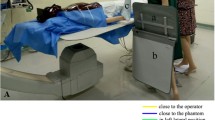Abstract
Objectives
To estimate the impact of endoaortic stents/mechanical heart valves on the output of an automatic exposure control (AEC) system and CT radiation dose.
Methods
In this phantom study, seven stents and two valves were scanned with varying tube voltage (80/100/120 kVp), AEC activation (enabled/disabled) and prosthesis (present/absent), for a total of 540 scans. For each prosthesis, the dose-length product (DLP) was compared between scans with the AEC enabled and disabled. Percentage confidence levels for differences due to the prosthesis were calculated.
Results
Differences between results with the AEC enabled and disabled were not statistically significant (p ≥ 0.059). In the comparison with and without the prosthesis, DLP was unchanged at 80 kVp and 100 kVp, while a slight increase was observed at 120 kVp. The radiation dose varied from 1.8 mGy to 2.4 mGy without the prosthesis and from 1.8 mGy to 2.5 mGy with the prosthesis (confidence level 37–100%).
Conclusions
The effect of the prosthesis on the AEC system was negligible and not clinically relevant. Therefore, disabling the AEC system when scanning these patients is not likely to provide a benefit.
Key points
• CT-AEC system is not impaired in patients with endoaortic prostheses/heart valves.
• Negligible differences may be observed only at 120 kVp.
• Disabling the AEC system in these patients is not recommended.





Similar content being viewed by others
References
Council Directive 2013/59/EURATOM (2014) Official Journal of the European Union. https://ec.europa.eu/energy/sites/ener/files/documents/CELEX-32013L0059-EN-TXT.pdf. Accessed June 7, 2016
No authors listed (2004) Proceedings of the second ALARA conference. February 28, 2004. Houston, Texas, USA. Pediatr Radiol 34(Suppl 3):S162–S246
Prasad KN, Cole WC, Haase GM (2004) Radiation protection in humans: extending the concept of as low as reasonably achievable (ALARA) from dose to biological damage. Br J Radiol 77:97–99
Lee CH, Goo JM, Ye HJ et al (2008) Radiation dose modulation techniques in the multidetector CT era: from basics to practice. Radiographics 28:1451–1459
McCollough CH, Bruesewitz MR, Kofler JM (2006) CT dose reduction and dose management tools: overview of available options. Radiographics 26:503–512
Rizzo SMR, Kalra MK, Maher MM, Blake MA, Toth TL, Saini S (2005) Do metallic endoprostheses increase radiation dose associated with automatic tube-current modulation in abdominal-pelvic MDCT? A phantom and patient study. Am J Roentgenol 184:491–496
Sardanelli F, Hunink MG, Gilbert FJ et al (2010) Evidence-based radiology: why and how? Eur Radiol 20:1–15
Acknowledgments
The scientific guarantor of this publication is Prof. Francesco Sardanelli. The authors of this manuscript declare no relationships with any companies whose products or services may be related to the subject matter of the article. The authors state that this work has not received any funding. One of the authors has significant statistical expertise. Institutional Review Board approval was not required because this is a phantom study. Methodology: Prospective, experimental, performed at one institution.
Author information
Authors and Affiliations
Corresponding author
Rights and permissions
About this article
Cite this article
Di Leo, G., Spadavecchia, C., Zanardo, M. et al. Should the automatic exposure control system of CT be disabled when scanning patients with endoaortic stents or mechanical heart valves? A phantom study. Eur Radiol 27, 2989–2994 (2017). https://doi.org/10.1007/s00330-016-4676-9
Received:
Revised:
Accepted:
Published:
Issue Date:
DOI: https://doi.org/10.1007/s00330-016-4676-9




